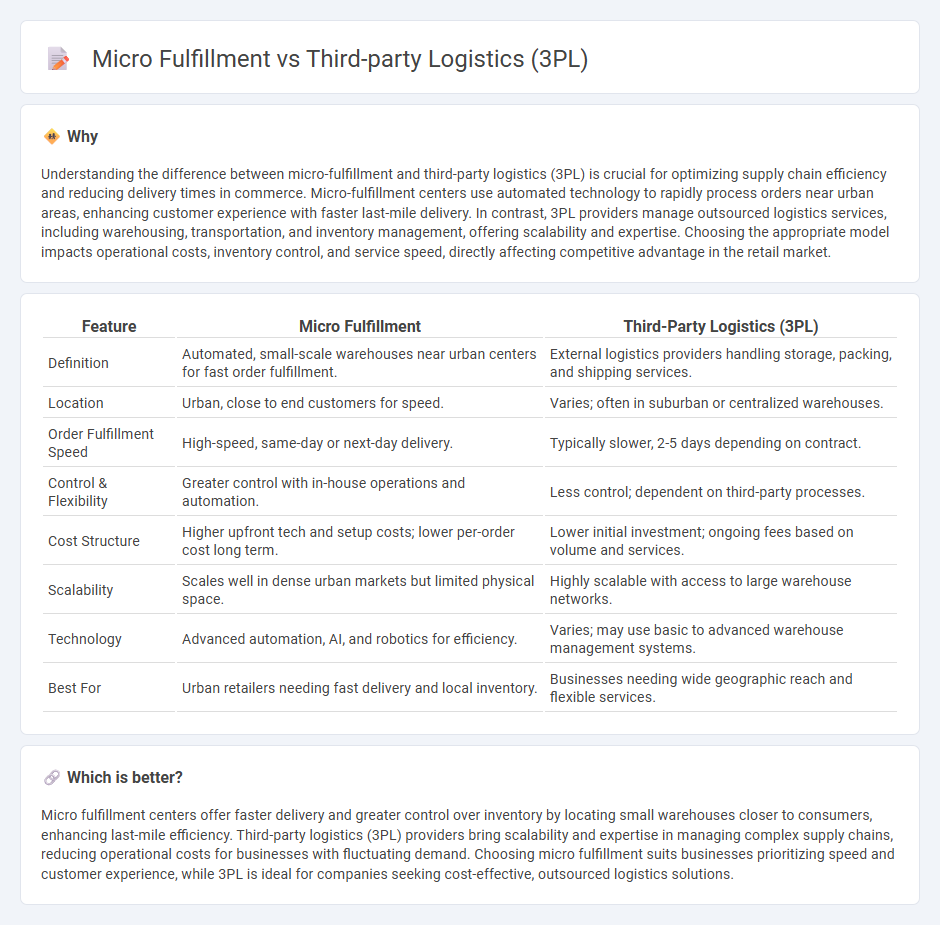
Micro fulfillment centers leverage advanced automation to expedite order processing within urban areas, reducing delivery times and last-mile costs compared to traditional third-party logistics (3PL) providers. While 3PL offers extensive warehousing and transportation networks to scale operations, micro fulfillment suits retailers aiming for rapid local order fulfillment and inventory accuracy. Explore how these solutions can transform your supply chain strategy and optimize customer satisfaction.
Why it is important
Understanding the difference between micro-fulfillment and third-party logistics (3PL) is crucial for optimizing supply chain efficiency and reducing delivery times in commerce. Micro-fulfillment centers use automated technology to rapidly process orders near urban areas, enhancing customer experience with faster last-mile delivery. In contrast, 3PL providers manage outsourced logistics services, including warehousing, transportation, and inventory management, offering scalability and expertise. Choosing the appropriate model impacts operational costs, inventory control, and service speed, directly affecting competitive advantage in the retail market.
Comparison Table
| Feature | Micro Fulfillment | Third-Party Logistics (3PL) |
|---|---|---|
| Definition | Automated, small-scale warehouses near urban centers for fast order fulfillment. | External logistics providers handling storage, packing, and shipping services. |
| Location | Urban, close to end customers for speed. | Varies; often in suburban or centralized warehouses. |
| Order Fulfillment Speed | High-speed, same-day or next-day delivery. | Typically slower, 2-5 days depending on contract. |
| Control & Flexibility | Greater control with in-house operations and automation. | Less control; dependent on third-party processes. |
| Cost Structure | Higher upfront tech and setup costs; lower per-order cost long term. | Lower initial investment; ongoing fees based on volume and services. |
| Scalability | Scales well in dense urban markets but limited physical space. | Highly scalable with access to large warehouse networks. |
| Technology | Advanced automation, AI, and robotics for efficiency. | Varies; may use basic to advanced warehouse management systems. |
| Best For | Urban retailers needing fast delivery and local inventory. | Businesses needing wide geographic reach and flexible services. |
Which is better?
Micro fulfillment centers offer faster delivery and greater control over inventory by locating small warehouses closer to consumers, enhancing last-mile efficiency. Third-party logistics (3PL) providers bring scalability and expertise in managing complex supply chains, reducing operational costs for businesses with fluctuating demand. Choosing micro fulfillment suits businesses prioritizing speed and customer experience, while 3PL is ideal for companies seeking cost-effective, outsourced logistics solutions.
Connection
Micro fulfillment centers enhance third-party logistics (3PL) by enabling faster, localized order processing and delivery, optimizing inventory management, and reducing last-mile delivery costs. 3PL providers leverage micro fulfillment to scale e-commerce operations efficiently, improve supply chain agility, and meet growing consumer demand for quick, accurate shipments. Integrating micro fulfillment into 3PL networks drives operational efficiency and boosts customer satisfaction in modern commerce.
Key Terms
Outsourcing
Third-party logistics (3PL) involves outsourcing supply chain management and distribution tasks to specialized providers, enabling companies to scale operations without investing heavily in infrastructure. Micro fulfillment centers, often operated by 3PLs or retailers, focus on rapid, localized order processing and delivery using automation technology to meet e-commerce demands efficiently. Explore how combining 3PL outsourcing with micro fulfillment can optimize supply chain agility and customer satisfaction.
Last-mile delivery
Third-party logistics (3PL) providers specialize in managing global supply chains and warehousing, leveraging extensive networks to optimize last-mile delivery efficiency for large-scale operations. Micro fulfillment centers are strategically located, automated hubs designed to expedite last-mile delivery in urban areas, reducing delivery times and costs by minimizing transportation distances. Explore the differences and benefits of 3PL versus micro fulfillment to optimize your last-mile logistics strategy.
Automation
Third-party logistics (3PL) providers leverage extensive automation technologies such as warehouse management systems (WMS), automated picking, and robotic sorting to streamline supply chain operations and enhance efficiency at scale. Micro fulfillment centers, on the other hand, employ hyper-local automated systems, including AI-driven inventory robotics and advanced conveyor solutions, to speed up order processing and enable rapid last-mile delivery in urban environments. Explore how automation in 3PL and micro fulfillment redefines logistics performance and customer satisfaction.
Source and External Links
What is 3PL (third-party logistics)? | Definition from TechTarget - A 3PL provider offers outsourced logistics services managing facets of procurement and fulfillment, including transportation and warehousing, enabling companies to focus on core competencies while controlling shipping costs effectively.
What is a 3PL? Third-party logistics definition, process, and resources - A 3PL is a partner that enhances supply chain efficiency by handling inventory management, warehousing, order fulfillment, and transportation, allowing businesses to streamline logistics and focus on growth.
How 3PLs Revolutionize Logistics and Supply Chain Management - Third-party logistics outsourcing involves expert companies providing comprehensive services such as transportation, warehousing, order fulfillment, and customs brokerage to help businesses optimize supply chain operations and concentrate on their core activities.
 dowidth.com
dowidth.com